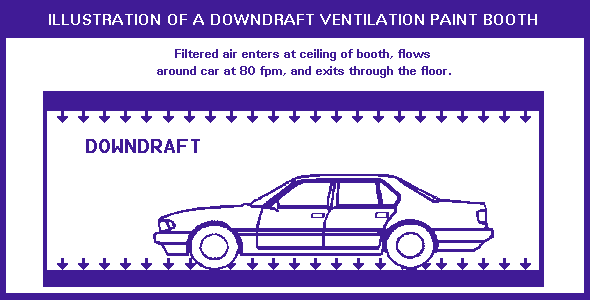Control of Paint Overspray in Autobody Repair Shops
1996
DHHS (NIOSH) Publication Number 96-106
Hazard
Hazardous components of paint spray include metals such as lead and chromium, polyisocyanates, and liquid organic solvents. Autobody workers may develop nervous disorders, skin and eye irritation, respiratory sensitization, asthma and reduced lung function from exposure to paint.
Controls
Effective control of worker exposure to paint overspray requires the proper selection of spray painting equipment, a properly designed and ventilated spray painting booth, and personal pro- tective equipment. Formal training and maintenance programs will help ensure that all equipment operates properly. Three types of control are recommended:
Spray Painting Guns
- HIGH VOLUME, LOW PRESSURE (HVLP) spray painting guns are recommended instead of conventional gravity or siphon-feed spray painting guns because HVLP guns cut paint overspray concentrations in half. HVLP guns transfer paint more efficiently and can reduce paint usage.
Paint Booth Ventilation
- DOWNDRAFT VENTILATION spray painting booths are recommended instead of Cross Draft or Semi-Downdraft Ventilation spray painting booths. Properly operated DOWNDRAFT booths produce lower concentrations of paint overspray compared to the other two types of booths. DOWNDRAFT booths produce a cleaner paint job that requires less buffing. (See ILLUSTRATION)
Respiratory Protection
- Properly used and maintained HVLP spray painting guns and downdraft booths will greatly reduce paint overspray concentrations, but they will not completely eliminate overspray from the air workers breathe. Therefore, PERSONAL RESPIRATORY PROTECTIVE EQUIPMENT is also recommended and a RESPIRATORY PROTECTION PROGRAM that contains all elements required by the OSHA standard (such as worker evaluation, selection of appropriate air-purifying or supplied-air respirators, fit-testing, training, and maintenance) will be needed to fully protect workers from this hazard.
Acknowledgments
The principal contributors to this HAZARD CONTROLS are William A. Heitbrink, Division of Physical Sciences and Engineering, and Jerome P. Flesch, Education and Information Division, NIOSH.
This document is in the public domain and may be freely copied or reprinted. NIOSH encourages all readers of this HAZARD CONTROLS to make it available to all interested employers and workers.
Control of Paint Overspray in Autobody Repair Shops [PDF – 161 KB]

